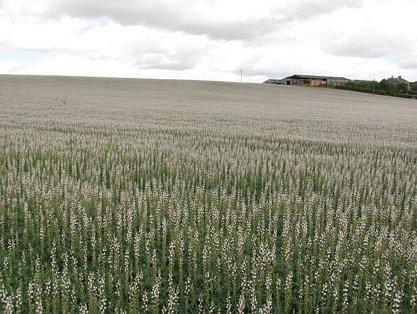Quick Facts
- The lupin plant is a legume capable of fixing N and consequently is a good break crop that can be produced using normal cereal production machinery.
- Lupins have a high protein content, making them a potentially valuable component for inclusion in feed rations.
- There are three different type of lupins: blue (narrow leaf), white and yellow which differ in protein content, plant architecture and yield potential. Varieties for autumn and spring sowing are available.
- Lupin breeding and production research is quite limited and a major constraint. Yields of up to 5t/ha are possible in Irish conditions (white lupins), with limited disease challenges to date.
- While lupins can be used successfully in animal diets and have some limited food potential, there is not currently a clearly defined market for the crop.
- For all involved in research and development at national or EU level, there is a dilemma as to whether to focus on a limited number of legume crops or try to develop many. Lupins may not receive a lot of support if the more focussed approach is taken.
Crop Description
- Lupins are of the fabacea family with three distinct types typically used: blue - narrow leaf (Lupinus.), white (Lupinus.albus) and yellow which differ in protein content, plant architecture and yield potential.
- Spring varieties are available of all three types, but the plant architecture varies between types and varieties. In Irish conditions spring sown lupins have moderate yield potential, poor yield stability and late harvest date compared to autumn sown types which can yield up to 5t/ha. Lupins have a significantly higher protein content than peas or beans (Table 1).
Table 1: Nutritional composition of Lupin species compared to other grain legumes
Grain legumes Crude protein (%) Lipids (%) Crude fibre (%) Lupins
Lupinusangustifolius (narrow-leaf/blue)
Lupins albus (white)
Lupinus luteus (yellow)
28-38
34-45
36-48
5-7
10-15
4-7
13-17
3-10
15-18Soybean 39.6 25.3 12.8 Faba beans 29.0 1.5 9.0 Peas 24.9 1.5 19.5 Source: LUKAA, 2015
Markets
Internationally, the market for Lupins is both for animal feed and human food and for
- As with other natively grown legumes, lupins can be processed and used on farms as a protein source in concentrate rations for ruminant or mono-gastric animals.
- Lupins can be conserved at a high moisture with crimping and acid preservative use.
- Feeding research has shown lupins to be a satisfactory protein source in both monogastric and ruminant diets. They can also be used in fish feeds.
- There is interest in lupin inclusion in human diets and its value. Studies have shown that lupin protein and fibre components have excellent functional properties in breads and other baked goods, meat products and beverages. Some studies claim lupin inclusion can have some beneficial health effects.
Suitability for Ireland
- With Irish imports for animal protein meal over 1 million tons annually, high protein lupins could help reduce imports. However the role of lupins in comparison with other legumes needs to be determined.
- Lupins have a different amino acid profile to beans making them more attractive in monogastric diets (pigs and poultry).
- In limited trials lupins have yield potential of up to 5 t/ha under Irish conditions.
- Lupins can cope with moderately low pH soils (5.0-7.0) and because of their N fixing ability they are suitable for low fertility sites.
- Light to medium textured soils allow early establishment of spring crops and earlier harvest, although heavier textured soils may give a yield advantage.
- While no major incidence of disease was found on lupins in Irish climate over six years (1995-2000) of field trials, BYMV and yellow rust can affect lupins.
- Weed growth can be problematic due to the open nature of the crop but multi-stem varieties are more competitive.
- Processing would be similar to peas but there has been limited processing in Ireland
- The quality of protein is good due to absence of tannins, and alkaloids
- Lupins are an ideal break crop in a rotation and fix nitrogen.
Rotation/Break Crop Benefits
- Incorporating lupins into rotations reduces disease challenges in succeeding cereal crops. Its N fixing capacity spares fertiliser N in the current and succeeding crop.
- Overall the rotational benefits would be similar to that brought by other legumes such as beans.
Research and Development Status
- Lupin breeding activity in Europe is very limited with small programmes in France, Italy and Germany, resulting in limited capacity to make progress generally or to adapt varieties for specific purposes or regions.
- While basic production knowledge is available, there is a significant deficit in all aspects of agronomy/production research including crop establishment, nutrition, disease, pest and weed control.
- While the basic feed value of lupins is known, there is scope for improved nutritional knowledge for both animal feed and human food use.
- The potential role for Lupins in Irish agriculture taking into account its unique attributes but also in comparison with competing break-crops needs to be determined.
Crop Production Summary
- Select a suitable site (soil type and rotation position). Yellow and blue lupins will tolerate more acidic soils and favour lighter or medium textured soils. White lupins will tlerate slightly heavier texture soils.
- Sowing date for winter varieties is in September, whereas mid-March to mid-April are most appropriate for spring varieties. Seed rates depend on variety types.
- As it fixes N, no applied N is required with P and K determined by soil test.
- While diseases are not very common due to the small areas grown, lupins are susceptible to yellow rust, bean mosaic virus and yellow rust.
- There are a number of pests that can attack lupins.
- Harvest can be late for some spring sown varieties. Some growers deliberately harvest at higher moisture for crimping and acid treatment for storage.



